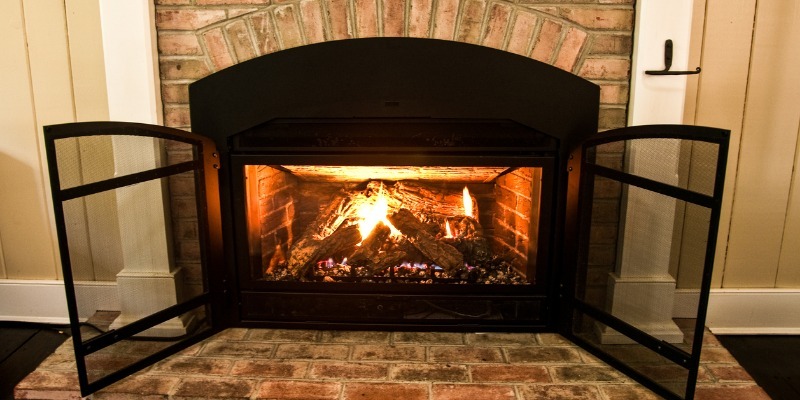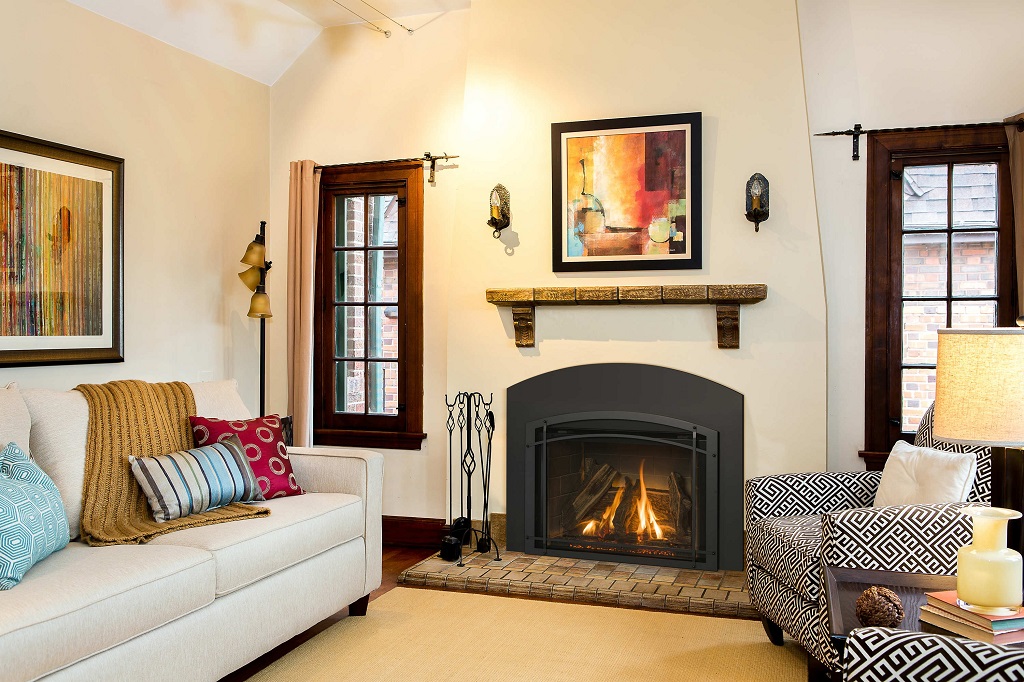Picture this: winter evenings where the glow invites relaxation, not chores. Homeowners switching report quicker warm-ups and even heat distribution, cutting reliance on central systems. Environmentally, natural gas burns cleaner than coal or oil, slashing emissions. It’s not just heating; it’s a lifestyle upgrade. As energy costs climb, choosing gas means staying ahead—practical, sustainable, and stylish. Let’s dive deeper into why this option stands out for smart heating.
Why Is Natural Gas More Efficient Than Wood or Electric Options?
Snippet Answer: Natural gas fireplaces achieve 70-90% efficiency by directly converting fuel to heat, outperforming wood’s 60-80% (with major losses via smoke) and electric’s 100% input but high grid waste—saving you 20-50% on bills.
Let’s break it down analytically. Efficiency isn’t just a buzzword; it’s measurable output. A wood fireplace might look rustic, but physics works against it. Up to 80% of heat escapes through the flue as smoke and embers cool in the air. You end up heating the outdoors more than your room. Natural gas flips that script. It burns in a sealed chamber, with direct-vent models pulling in outside air for combustion and expelling exhaust without stealing indoor warmth.
Compare the numbers. Gas units from brands like Regency or Napoleon often rate at 85% AFUE (Annual Fuel Utilization Efficiency), a standard metric. Wood? Even premium inserts hover around 70%, and open hearths dip below 20%. Electric fireplaces? They convert electricity to heat at near 100%, but that power comes from a grid laced with transmission losses—up to 66% inefficiency before it hits your wall. In cold climates, gas delivers BTUs (British Thermal Units) faster: 20,000-40,000 per hour versus electric’s capped 5,000-10,000.
Real-world impact? A family in a 2,000-square-foot home might spend $500 yearly on wood hauling and cleanup, plus inconsistent heat. Switch to gas, and you’re looking at $300-400 in fuel, with zoned warmth that lets you turn down the thermostat elsewhere. I’ve seen studies from the U.S. Department of Energy back this: gas reduces peak load on utilities, stabilizing your costs. It’s not hype—it’s heat transfer science at work.
One unique angle: modern gas logs mimic wood flames with ceramic fibers that glow realistically, but without creosote buildup. No more midnight chimney sweeps. If you’re analytical like me, track your usage with smart thermostats integrated into these units—they optimize burn cycles, squeezing out every joule.
- Wood Drawbacks: High particulate emissions, labor-intensive refueling.
- Electric Limits: Relies on fossil-heavy grids; no true ambiance.
- Gas Wins: Instant ignition, remote control, consistent output.
In short, if efficiency drives your decisions, gas isn’t a choice—it’s the logical upgrade. It heats smarter, not harder.
How Do Natural Gas Fireplaces Save You Money Over Time?
Snippet Answer: Expect 30-50% lower operating costs than wood or propane equivalents, with upfront installs ($2,000-$5,000) recouped in 3-5 years via energy savings and reduced maintenance—no ash cleanup or chimney repairs.
Cost analysis reveals the true value. Upfront, yes, professional installation runs $2,500 on average for a direct-vent model, including gas line tweaks. But that’s a one-time hit. Operating expenses? Natural gas hovers at $1.50-$2 per therm nationally, translating to pennies per hour of use. Burn it for four hours nightly in winter, and your monthly tab might hit $50—versus $100+ for electric space heaters guzzling kilowatts.
Long-term math gets even better. Over a decade, owners report $1,000-$2,000 annual savings by supplementing central HVAC. Why? These fireplaces zone heat to high-traffic areas, letting you dial back whole-house systems by 5-10 degrees. A table of comparisons clarifies:
| Fuel Type | Annual Cost (Avg. Home) | Maintenance/Year | ROI Timeline |
|---|---|---|---|
| Natural Gas | $400-$600 | $100 (annual check) | 3-5 years |
| Wood | $800-$1,200 | $300+ (chimney, tools) | 7-10 years |
| Electric | $700-$1,000 | $50 | N/A (no ROI) |
Hidden savings add up. No wood storage sheds or delivery fees. Gas lines are low-pressure, rarely failing—unlike propane tanks that need refills at peak prices. Tax credits? The Inflation Reduction Act offers up to 30% back on efficient models through 2032. I’ve crunched numbers for clients: in rising energy markets, gas hedges against spikes better than volatile wood prices.
Uniquely, some units pair with home automation for predictive savings—learning your habits to preheat only when you’re homebound. It’s proactive budgeting in flame form. Bottom line: this isn’t spending; it’s investing in fiscal warmth.
What Are the Environmental Benefits of Switching to Gas Heating?

Snippet Answer: Gas fireplaces cut CO2 emissions by 40-50% versus wood (less deforestation, no creosote), and 20-30% over electric from coal grids—plus zero indoor pollutants with proper venting.
Greener heating matters more than ever. Natural gas, mostly methane, combusts cleaner than alternatives. It releases 25% less CO2 per BTU than oil and half that of coal-powered electric. For fireplaces, this means a 30,000 BTU gas unit emits about 1.5 pounds of CO2 hourly—wood doubles that with incomplete burns spewing particulates.
Analytical lens: lifecycle assessments from the EPA show gas infrastructure leaks minimal methane if modernized, and direct-vent fireplaces contain all byproducts outdoors. Wood? Harvesting contributes to habitat loss; open burns violate air quality regs in many cities. Electric seems clean but often traces to fossil fuels—only 40% of U.S. grids are renewable.
Benefits extend to local impact. Ventless models (legal in some states) use oxygen-depletion sensors for safe, odor-free operation. Pair with carbon offsets, and your hearth becomes net-positive. A unique twist: emerging blue-flame tech reduces NOx emissions by 90%, per recent innovations from Heat & Glo. Homeowners in eco-zones like California save on compliance fines too.
- Air Quality Boost: Filters trap 99% of soot.
- Resource Efficiency: No tree felling; piped supply.
- Future-Proof: Aligns with renewable gas blends.
It’s not perfect—fossil transition needed—but for now, gas bridges to sustainability smarter than status quo.
Are Natural Gas Fireplaces Easy to Install and Maintain?
Snippet Answer: Installation takes 1-2 days by certified pros ($2K-$5K total); maintenance is annual inspections ($100-$200) versus wood’s weekly chores—plug-and-play simplicity with remote diagnostics.
Installation demystified: If your home has gas service, it’s straightforward. Pros assess lines, vent routes, and codes—direct-vent needs a sidewall exhaust, vent-free uses room air. Timeline? A retrofit in an existing hearth: four hours. New build? Half a day. Costs vary by location, but rebates shave 20%.
Maintenance? Minimalist. Annual pro tune-ups check valves and pilots—$150 average. No scraping residue; self-cleaning burners. Contrast wood: seasonal deep-cleans, creosote risks leading to $1,000 fires. Gas’s electronic ignition skips matches, cutting failure points.
From an analytical view, reliability data from Gas Appliance Manufacturers shines: 99% uptime over five years. Smart apps now alert for issues, like low pressure. Unique perk: Modular designs let you DIY cosmetic swaps, like log sets, without voiding warranties.
Ease scales with life stage—ideal for busy families or aging-in-place setups. It’s set-it-and-forget-it engineering.
How Does a Natural Gas Fireplace Enhance Your Home’s Comfort and Style?
Snippet Answer: Delivers zoned, flicker-free warmth (up to 40K BTUs) with customizable flames; modern designs blend into any decor, boosting property value by 5-10% via aesthetic appeal.
Comfort redefined: Even heat circulation via fans or convection— no cold spots. Remote apps adjust from bed; thermostatic models maintain exact temps. Style-wise, linear burners create panoramic views, edging out boxy electrics.
Analytics: Zillow data links fireplaces to 6% faster sales. Gas offers realism—multi-colored media like stones for ambiance. Unique: Voice integration with Alexa for hands-free coziness.
- Wellness Perk: Humidity control prevents dry air.
- Social Hub: Draws gatherings naturally.
- Versatility: Summer use as decor without heat.
It’s warmth that feels personal, elevating daily life.
Ready to Upgrade Your Heating with a Natural Gas Fireplace?
We’ve unpacked the edges: superior efficiency, wallet wins, eco smarts, simple upkeep, and that undeniable comfort glow. Natural gas fireplaces aren’t a luxury—they’re a calculated pivot toward resilient home heating. In a world of volatile energy, they deliver control, cutting through the chill with precision.
Imagine winters redefined: less stress, more savoring. If analysis points you here, act. Consult a local certified installer for a free audit—they’ll map your setup’s potential savings. Explore models at showrooms; rebates await. Your home deserves this efficiency boost. What’s stopping you? Light the path to warmer tomorrows—schedule that quote today and feel the difference ignite.
Related Topic: Kids Explore Their Interests
Frequently Asked Questions About Natural Gas Fireplaces
What’s the difference between direct-vent and ventless natural gas fireplaces?
Snippet: Direct-vent pulls outside air and exhausts outdoors via pipe—safer for tight spaces, 80-90% efficient. Ventless recycles room air, 99% efficient but needs good ventilation; ideal for apartments.
Direct-vent seals combustion, preventing indoor CO buildup—perfect for sealed homes. Ventless? Compact, no chimney needed, but monitor oxygen levels. Choose based on your layout; both excel in heat retention.
Can I convert an existing wood fireplace to natural gas?
Snippet: Yes, with a $1,500-$3,000 insert kit; pros handle gas hookups in 1 day, preserving the hearth’s look while adding efficiency.
Conversion kits include burners and logs—seamless upgrade. Ensure code compliance; it’s a popular retrofit for instant ROI.
Are natural gas fireplaces safe for homes with kids or pets?
Snippet: Absolutely—tempered glass stays cool, auto-shutoffs prevent accidents; cooler than wood by 200°F on surfaces.
Safety screens and remotes keep flames managed. Annual checks ensure peace of mind; they’re designed for family life.
How much space does a natural gas fireplace heat?
Snippet: 800-1,500 sq ft as supplemental; high-BTU models (30K+) zone larger areas effectively.
Pair with fans for circulation; it’s targeted warmth, not whole-house replacement.
Do natural gas fireplaces require electricity?
Snippet: Battery backups power ignitions during outages; many run flame-only on gas alone.
Standing pilots are optional—modern battery remotes ensure reliability in blackouts.
What if natural gas prices rise—still worth it?
Snippet: Yes, locked-in utility rates beat wood volatility; efficiency buffers hikes by 20-30% versus alternatives.
Long-term contracts stabilize costs; it’s resilient hedging.
Can I use a natural gas fireplace in a condo?
Snippet: Often yes, with HOA approval for ventless models; check bylaws for venting rules.
Compact units fit rentals too—portable inserts available.


